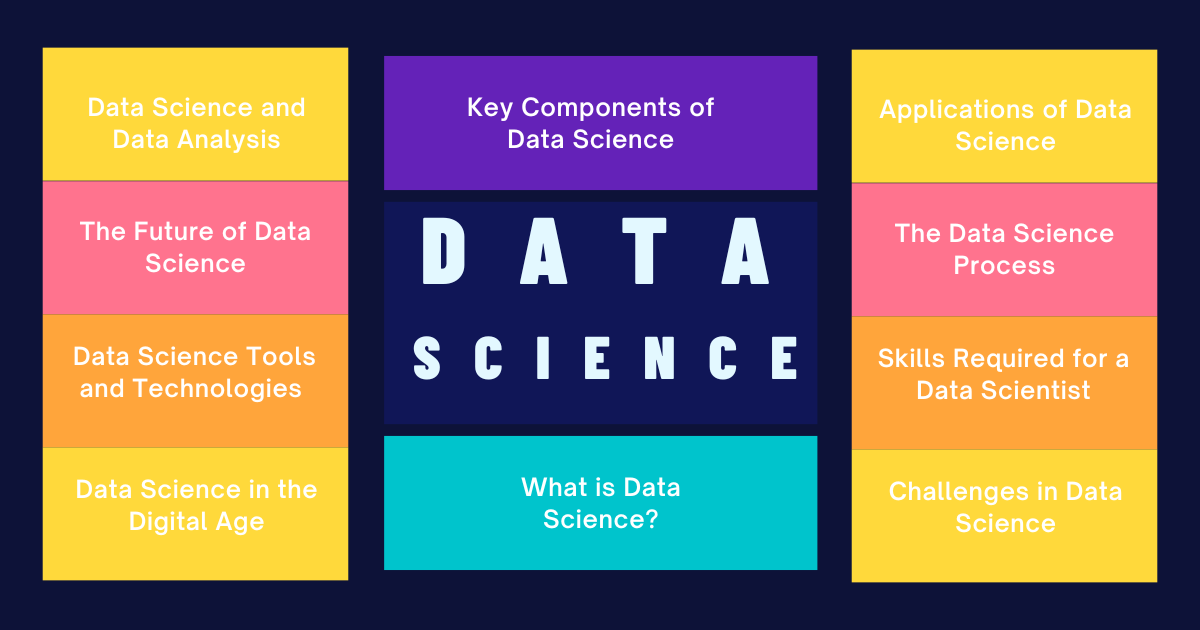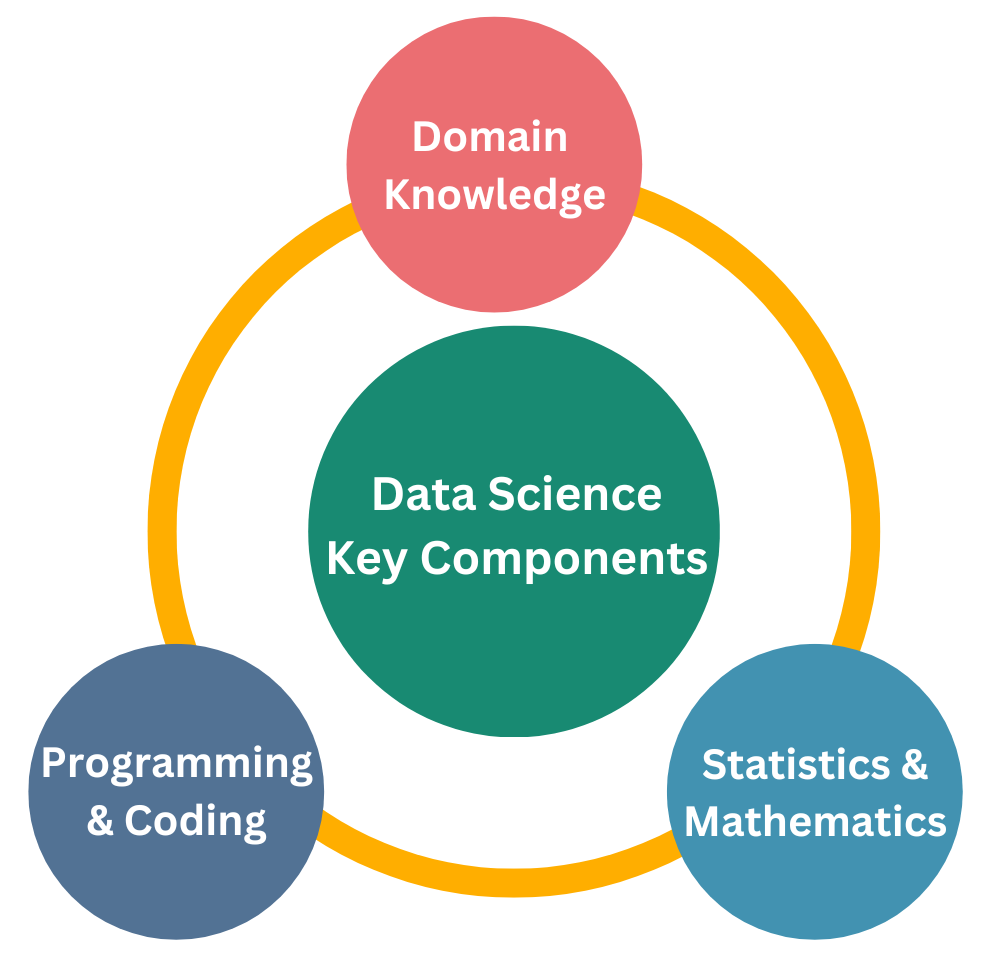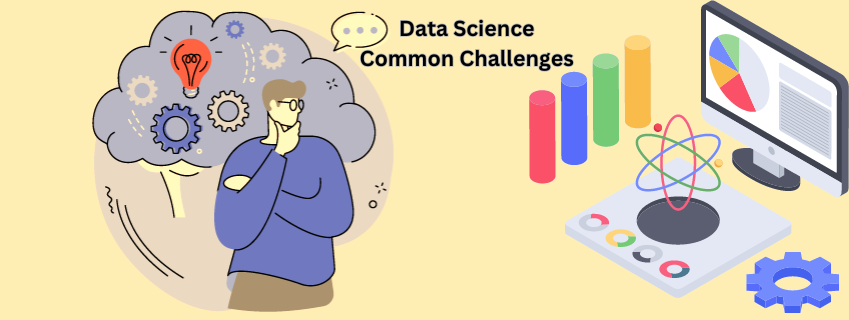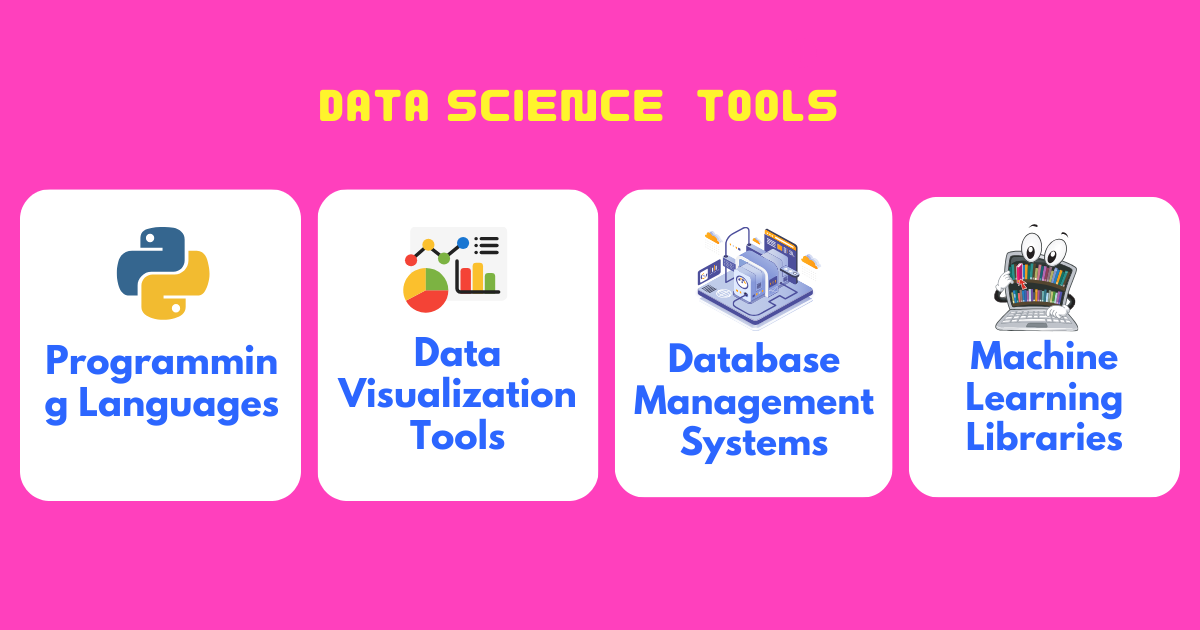In our rapidly evolving digital landscape, the question ‘What is Data Science’ echoes through the corridors of innovation. It is not merely a buzzword but a transformative field that plays a pivotal role in extracting meaningful insights from vast sets of data.
Let’s delve into the intricacies of Data Science, exploring not only what it is but also its components, applications, challenges, and the profound impact it has on various industries.

At its core, Data Science is an interdisciplinary field that utilizes scientific methods, processes, algorithms, and systems to extract knowledge and insights from structured and unstructured data. It combines elements of statistics, mathematics, and computer science to analyze and interpret complex data sets.
Key Components of Data Science
One of the most effective tools for tackling some of the most important issues facing the world nowadays is Data Science. From developing new medical treatments to improving business efficiency, data scientists are using their skills to make a real difference in the world.

This text will explore the key components of data science, including statistics and mathematics, programming and coding, and domain knowledge. We will also discuss how these components work together to enable data scientists to extract insights from data and make informed decisions.
1. Statistics and Mathematics
The foundation of Data science lies in statistics and mathematics. Professionals in this field leverage statistical models to identify patterns, trends, and correlations within data, providing a solid basis for decision-making.
2. Programming and Coding
Proficiency in programming languages such as Python and R is crucial for a data scientist. These languages facilitate data manipulation, analysis, and the implementation of machine learning algorithms.
3. Domain Knowledge
Beyond technical skills, domain knowledge is essential. Data scientists must understand the industry they are working in to generate relevant insights and contribute meaningfully to decision-making processes.
Applications of Data Science
Data science is a rapidly evolving field with a wide range of applications in various sectors. From business analytics to healthcare to social media, data science is transforming the way we work and live.

Business Analytics
Data science plays a crucial role in business analytics, providing actionable insights for strategic planning. By analyzing data on customer behavior, market trends, and financial performance, data scientists can help businesses make informed decisions about product development, marketing campaigns, and resource allocation.
For example, data science can be used to:
- Determine which customer segments to target with personalized advertising strategies.
- Predict customer churn and take steps to retain them.
- Optimize supply chains and reduce costs.
- Develop new products and services that meet customer needs.
Healthcare
In healthcare, data science is used to improve patient care and develop new medical treatments. By analyzing data on patient demographics, medical history, and treatment outcomes, data scientists can identify patterns and trends that can be used to predict disease risk, develop personalized treatment plans, and improve the quality of care.
For example, data science can be used to:
- Develop predictive models to identify patients at risk of certain diseases.
- Develop personalized treatment plans based on a patient’s individual characteristics.
- Improve the efficiency of clinical trials.
- Speed up the creation of new medications and treatments.
Finance
The finance industry benefits from data science through fraud detection, risk management, and algorithmic trading. Data scientists use data on financial markets, customer transactions, and risk factors to develop algorithms that can identify fraudulent activity, assess risk, and make investment decisions.
Data science, for instance, can be applied to:
- Detect and prevent fraudulent transactions.
- Assess the creditworthiness of borrowers.
- Develop algorithmic trading strategies.
- Manage investment portfolios.
Social Media
Social media platforms utilize data science for user engagement, content recommendation, and targeted advertising. Algorithms analyze user behavior, such as the pages they visit, the posts they like, and the people they follow, to deliver personalized experiences.
Data science, for instance, can be applied to:
- Recommend content to users that is likely to interest them.
- Display advertisements to users based on their interests.
- Identify and remove harmful content, such as hate speech and misinformation.
The Data Science Process

The data science process is a systematic approach to extracting insights from data. It involves four key steps:
- Data Collection: The first step is to collect relevant data from a variety of sources. This may include databases, surveys, social media, and sensors. The data should be aligned with the objectives of the analysis.
- Data Cleaning and Preprocessing: Raw data often contains errors and inconsistencies. Data scientists use a variety of techniques to clean and preprocess the data to ensure accuracy and reliability. This may involve removing errors, filling in missing values, and converting the data into a consistent format.
- Data Analysis: Data analysis involves exploring and interpreting the data using statistical methods and machine learning algorithms to identify patterns and trends. This may involve creating visualizations, running statistical tests, and building predictive models.
- Model Building and Evaluation: Once the data has been analyzed, data scientists can build models to make predictions or recommendations. These models are typically evaluated on a held-out test set to ensure that they generalize well to new data.
The data science process is iterative. Data scientists may need to go back and forth between the different steps as they learn more about the data and their objectives.
Example
A data scientist might be hired by a company to help them understand their customer behavior. The data scientist would first collect data on customer demographics, purchase history, and website interactions. They would then clean and preprocess the data to ensure that it is accurate and reliable.
Next, the data scientist would analyze the data to identify patterns and trends. They might use statistical methods to segment customers into different groups or machine learning algorithms to build predictive models to predict customer churn.
Finally, the data scientist would build and evaluate models to make recommendations to the company on how to improve customer retention. They might recommend targeted marketing campaigns, loyalty programs, or changes to the company’s website or product offerings.
The data science process is a powerful tool for extracting insights from data and solving real-world problems. By understanding the different steps involved, we can better appreciate the value of data science and the impact that it can have on our lives.
Common Tasks that Data Scientists Perform
Data scientists use a variety of tools and techniques, including statistics, machine learning, artificial intelligence, and computer science. They also need to have a deep understanding of the business domain in which they are working in order to ask the right questions and extract the most relevant insights from the data.
- Collect and prepare data: Data scientists typically start by collecting data from a variety of sources, such as databases, surveys, and social media. The data must be cleansed and made ready for analysis after it has been gathered. This may involve removing errors, formatting the data consistently, and filling in missing values.
- Analyze data: Data scientists use a variety of statistical and machine-learning techniques to analyze the data. They may use this analysis to identify patterns and trends, build predictive models, or segment customers.
- Visualize data: Data scientists use data visualization tools to create charts, graphs, and other visuals that communicate the insights from the data in a clear and concise way.
Skills Required for a Data Scientist
Data scientists are in high demand across a wide range of industries, from healthcare to finance to technology. To be successful in this field, it is important to have a combination of technical and soft skills.
Technical Skills
The following are some of the most important technical skills for data scientists:
- Programming languages: Data scientists need to be proficient in at least one programming language, such as Python, R, or Scala. These languages are used for data manipulation, analysis, and machine learning.
- Data manipulation: Data scientists need to be able to clean, prepare, and manipulate data sets. This includes removing errors, formatting the data consistently, and filling in missing values.
- Machine learning: Machine learning is a key component of data science. Data scientists need to have a good understanding of machine learning algorithms and be able to apply them to solve real-world problems.
Soft Skills
In addition to technical skills, data scientists also need to have strong soft skills. Some of the most important soft skills for data scientists include:
- Analytical skills: Data scientists need to be able to interpret complex data sets and identify patterns and trends. They must also possess the ability to solve problems and think critically.
- Communication skills: Data scientists need to be able to communicate their findings effectively, both to technical and non-technical audiences. They must be able to concisely and effectively communicate difficult ideas.
- Teamwork skills: Data scientists often work as part of a team with other data scientists, engineers, and product managers. They need to be able to collaborate effectively and share their knowledge with others.
Data scientists play a crucial role in helping organizations make informed decisions. By developing a combination of technical and soft skills, aspiring data scientists can position themselves for success in this exciting and growing field.
Challenges in Data Science

Data science is a rapidly evolving field with the potential to solve some of the world’s most pressing problems. However, it also comes with its own set of challenges, such as big data management, privacy concerns, and the interpretability of models.
This text will explore the challenges in data science and discuss how they can be addressed. We will also discuss the importance of using data science responsibly and ethically.
1. Challenges in Data Science
Data science is a powerful tool with immense potential to solve real-world problems. It does, however, come with a unique set of difficulties.
2. Big Data Management
One of the biggest challenges in data science is big data management. The amount of data that is collected and stored is growing exponentially, and traditional data management solutions are often inadequate to handle this big data. Data scientists need to adopt scalable solutions to store, process, and analyze big data effectively.
3. Privacy Concerns
Another challenge in data science is privacy concerns. As data collection becomes more pervasive, individuals are becoming increasingly concerned about their privacy. Data scientists need to strike a balance between data utilization and individual privacy. This means using data responsibly and ethically, and ensuring that individuals have control over their own data.
4. Interpretability of Models
Some machine learning models are very complex, and it can be difficult to understand how they make predictions. This lack of interpretability can make it difficult to trust the model predictions and to identify potential biases in the model. Data scientists need to develop methods to improve the interpretability of machine learning models.
In addition to these challenges, data scientists also face challenges in finding skilled talent and collaborating with other stakeholders in the organization.
5. Addressing the Challenges
There are a number of things that can be done to address the challenges in data science.
- Big Data Management: Data scientists can adopt scalable solutions such as cloud computing and distributed computing to manage big data. They can also use data compression and other techniques to reduce the size of the data.
- Privacy Concerns: Data scientists can use anonymization and pseudonymization techniques to protect the privacy of individuals. In order to obtain and use people’s data, they can also get their consent.
- Interpretability of Models: Data scientists can use explainable AI (XAI) methods to improve the interpretability of machine learning models. They can also develop models that are simpler and easier to understand.
By addressing these challenges, data scientists can help to ensure that data science is used responsibly and ethically to solve real-world problems.
Data Science and Data Analysis
Data science and data analysis are two closely related fields, but they have some key differences.
Data science is a broader field that encompasses data analysis, as well as other areas such as data engineering and machine learning. Data scientists create prediction models, create new algorithms, and glean insights from data using statistical and computational techniques.
Data analysis is a more focused field that involves analyzing data to gain insights and inform business decisions. Data analysts typically use a variety of statistical and data visualization tools to identify patterns and trends in the data, and to communicate their findings to others.
Here is a table that summarizes the key differences between data science and data analysis:
| Characteristic | Data Science | Data Analysis |
|---|---|---|
| Scope | Broader encompasses data analysis, data engineering, and machine learning | More focused on analyzing data to gain insights and inform business decisions |
| Skills | Strong statistical and computational skills, as well as knowledge of machine learning and algorithms | Strong statistical and data visualization skills, as well as good business acumen |
| Tools and techniques | Statistics, machine learning, artificial intelligence, and computer science | Statistics, data visualization tools, and business intelligence tools |
| Focus | Extracting insights from data and developing new algorithms | On gaining insights from data to inform business decisions |
In general, data scientists have a more technical background and are more focused on developing new tools and techniques for data analysis. Data analysts, on the other hand, have a more business-oriented background and are more focused on using data to solve real-world business problems.
However, the lines between data science and data analysis are becoming increasingly blurred. Many data scientists now work on projects that are directly focused on solving business problems, and many data analysts now use machine learning and other advanced techniques in their work.
Ultimately, the best way to decide which field is right for you depends on your skills and interests. If you are interested in developing new tools and techniques for data analysis, then data science may be a good fit for you. If you are more interested in using data to solve real-world business problems, then data analysis may be a better choice.
The Future of Data Science
The future of data science is promising, with continuous advancements and emerging technologies shaping the landscape.
1. Emerging Technologies
Emerging technologies such as artificial intelligence (AI), blockchain, and edge computing are poised to revolutionize the field of data science. AI can be used to develop more sophisticated machine learning models that can learn from data and make predictions more accurately. Blockchain can be used to create secure and decentralized data-sharing networks. Edge computing can be used to analyze data in real-time, closer to where it is generated.
These technologies are opening up new possibilities for data analysis and interpretation. For example, AI-powered data science tools can help researchers identify new drug targets and develop personalized treatment plans for patients. Blockchain-based data-sharing platforms can enable companies to share data securely and collaborate on research projects. Edge computing can be used to analyze sensor data from industrial machines to predict maintenance needs and prevent downtime.
2. Job Opportunities
Data scientists are becoming more and more in demand across all industries. Companies in healthcare, finance, technology, and other sectors are all looking for data scientists to help them make informed decisions and solve real-world problems. The future job market will see an increased need for professionals with expertise in data science.
3. Continuous Learning in the Field
Given the rapid evolution of technology, continuous learning is essential for data scientists to stay updated with the latest tools and methodologies. Data scientists need to be proactive about learning new technologies and skills. They can do this by attending conferences, reading industry publications, and taking online courses.
Data Science Tools and Technologies

Data scientists gather, clean, analyze, and visualize data using a range of instruments and technologies. Among the most widely used instruments and technologies are:
Programming Languages
- Python: Data science makes extensive use of this general-purpose programming language. It is renowned for its readability, simplicity, and a large collection of data science tools.
- R: R is a software environment and programming language created especially for statistical computing and graphics. Because of its robust statistical skills and extensive library of programs for data analysis and visualization, it is well-liked by data scientists.
Database Management Systems
- SQL: SQL (Structured Query Language) is a programming language used to communicate with and manipulate data in relational database management systems. It is essential for data scientists to be able to use SQL to extract data from databases for analysis.
Machine Learning Libraries
- TensorFlow: TensorFlow is an open-source software framework that uses data flow graphs to do numerical calculations. It is frequently employed in the creation and instruction of machine learning models.
- Scikit-learn: For the Python programming language, Scikit-learn is a free machine learning package. It has several different machine-learning techniques, such as dimensionality reduction, clustering, regression, and classification.
Data Visualization Tools
- Tableau: Tableau is a data visualization software package that allows users to create interactive dashboards and reports. It is popular among data scientists for its ease of use and powerful visualization capabilities.
- Power BI: Power BI is a business intelligence and data visualization platform from Microsoft. It offers a wide range of features for data analysis and visualization, including interactive dashboards, reports, and maps.
These are just a few of the many tools and technologies that data scientists use in their work. The specific tools and technologies that a data scientist uses will depend on the specific tasks that they are working on and their personal preferences.
In addition to the tools and technologies listed above, data scientists may also use other tools such as cloud computing platforms (e.g., AWS, Azure, GCP), big data processing platforms (e.g., Apache Hadoop, Apache Spark), and natural language processing (NLP) libraries (e.g., NLTK, spaCy).
Data scientists are constantly using new tools and technologies to improve their work. By staying up-to-date with the latest trends and developments, data scientists can position themselves for success in this exciting and growing field.
Data Science in the Age of Digital Transformation
Data science is a driving force behind the ongoing digital transformation across industries. It is enabling organizations to innovate, grow their businesses, and improve their customer experiences.
1. Role in Innovation
Data-driven innovation is at the forefront of digital transformation. Data scientists are using data to develop new business models, products, and services. For example, Netflix uses data to recommend movies and TV shows to its users, and Amazon uses data to recommend products to its customers.
New technologies are also being developed using data science. For example, data scientists are using data to develop self-driving cars, improve medical diagnostics, and create new financial products and services.
2. Driving Business Growth
Companies that embrace data science gain a competitive edge by leveraging insights to drive innovation, improve customer experiences, and optimize operations.
For example, Walmart uses data to optimize its supply chain and reduce costs. Airbnb uses data to improve its search algorithm and make it easier for travelers to find the perfect place to stay. And Spotify uses data to personalize its music recommendations for each user.
Data science is also being used to improve customer service. For example, banks are using data to detect fraud and prevent identity theft. Airlines are using data to predict flight delays and cancellations so that they can better communicate with passengers.
How to Learn Data Science on Your Own
The allure of data science is undeniable: unraveling hidden patterns, extracting insights, and shaping the future with the power of information. But where do you start if you’re driven to embark on this exciting journey, but lack a formal background or structured program?
Fear not, aspiring data warrior, for the path to self-taught mastery is paved with resources and opportunities. Here’s your roadmap to kickstart your data science adventure:
1. Foundational Pillars:
- Math & Statistics: These are the cornerstones of data analysis. Start with basic statistics, then delve into probability, linear algebra, and calculus. Online courses, textbooks, and practice problems are your allies.
- Programming: Python and R reign supreme in data science. Choose one and dive in! Interactive tutorials, coding challenges, and online communities can guide your progress.
2. Data Wrangling Wizards:
- Databases: Understand how data is stored and accessed. Explore SQL, the lingua franca of relational databases, through online tutorials and practice platforms.
- Data Cleaning & Manipulation: Learn to wrangle messy data into usable form. Master data cleaning techniques and explore libraries like Pandas (Python) and dplyr (R).
3. Unveiling the Magic:
- Machine Learning: This is where data transforms into predictions and insights. Start with supervised learning basics like linear regression and decision trees. Online courses, platforms like Kaggle, and open-source libraries like scikit-learn (Python) and caret (R) are your playgrounds.
- Data Visualization: Tell compelling stories with your data. Explore libraries like Matplotlib (Python) and ggplot2 (R) and learn visualization best practices.
4. Sharpen Your Tools:
- Projects are your weapons: Don’t just learn, do! Find datasets online, participate in hackathons, or create your own project. This is where you solidify your skills and showcase your potential.
- Community is your compass: Connect with other aspiring data scientists through forums, online groups, and meetups. Share knowledge, ask questions, and learn from each other’s experiences.
Remember: The journey is continuous. Stay curious, embrace challenges, and never stop learning. With dedication, the world of data science awaits your exploration.
Conclusion
In conclusion, Data Science is a dynamic field that continues to shape our digital landscape. From predictive analytics to machine learning, its applications are diverse and impactful. As industries undergo digital transformation, the demand for skilled data scientists will only increase. However, with great power comes great responsibility. Ethical considerations must be prioritized to ensure the responsible use of data and avoid biases in algorithms. Whether you’re an aspiring data scientist or a business leader, understanding the nuances of Data Science is crucial in navigating the data-driven future.
Leave a Reply
You must be logged in to post a comment.